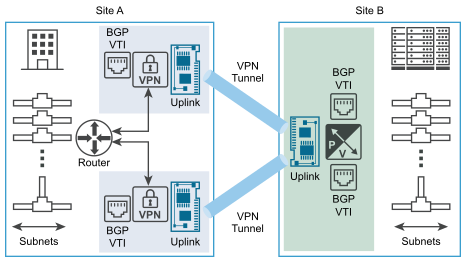Route-based IPSec VPN provides tunneling on traffic based on the static routes or routes learned dynamically over a special interface called virtual tunnel interface (VTI) using, for example, BGP as the protocol. IPSec secures all the traffic flowing through the VTI.
- OSPF dynamic routing is not supported for routing through IPSec VPN tunnels.
- Dynamic routing for VTI is not supported on VPN that is based on Tier-1 gateways.
Route-based IPSec VPN is similar to Generic Routing Encapsulation (GRE) over IPSec, with the exception that no additional encapsulation is added to the packet before applying IPSec processing.
In this VPN tunneling approach, VTIs are created on the NSX Edge node. Each VTI is associated with an IPSec tunnel. The encrypted traffic is routed from one site to another site through the VTI interfaces. IPSec processing happens only at the VTI.
VPN Tunnel Redundancy
You can configure VPN tunnel redundancy with a route-based IPSec VPN session that is configured on a Tier-0 gateway. With tunnel redundancy, multiple tunnels can be set up between two sites, with one tunnel being used as the primary with failover to the other tunnels when the primary tunnel becomes unavailable. This feature is most useful when a site has multiple connectivity options, such as with different ISPs for link redundancy.
- In NSX-T Data Center, IPSec VPN tunnel redundancy is supported using BGP only.
- Do not use static routing for route-based IPSec VPN tunnels to achieve VPN tunnel redundancy.
The following figure shows a logical representation of IPSec VPN tunnel redundancy between two sites. In this figure, Site A and Site B represent two data centers. For this example, assume that NSX-T Data Center is not managing the Edge VPN Gateways in Site A, and that NSX-T Data Center is managing an Edge Gateway virtual appliance in Site B.

As shown in the figure, you can configure two independent IPSec VPN tunnels by using VTIs. Dynamic routing is configured using BGP protocol to achieve tunnel redundancy. If both IPSec VPN tunnels are available, they remain in service. All the traffic destined from Site A to Site B through the NSX Edge node is routed through the VTI. The data traffic undergoes IPSec processing and goes out of its associated NSX Edge node uplink interface. All the incoming IPSec traffic received from Site B VPN Gateway on the NSX Edge node uplink interface is forwarded to the VTI after decryption, and then usual routing takes place.
You must configure BGP HoldDown timer and KeepAlive timer values to detect loss of connectivity with peer within the required failover time. See Configure BGP.